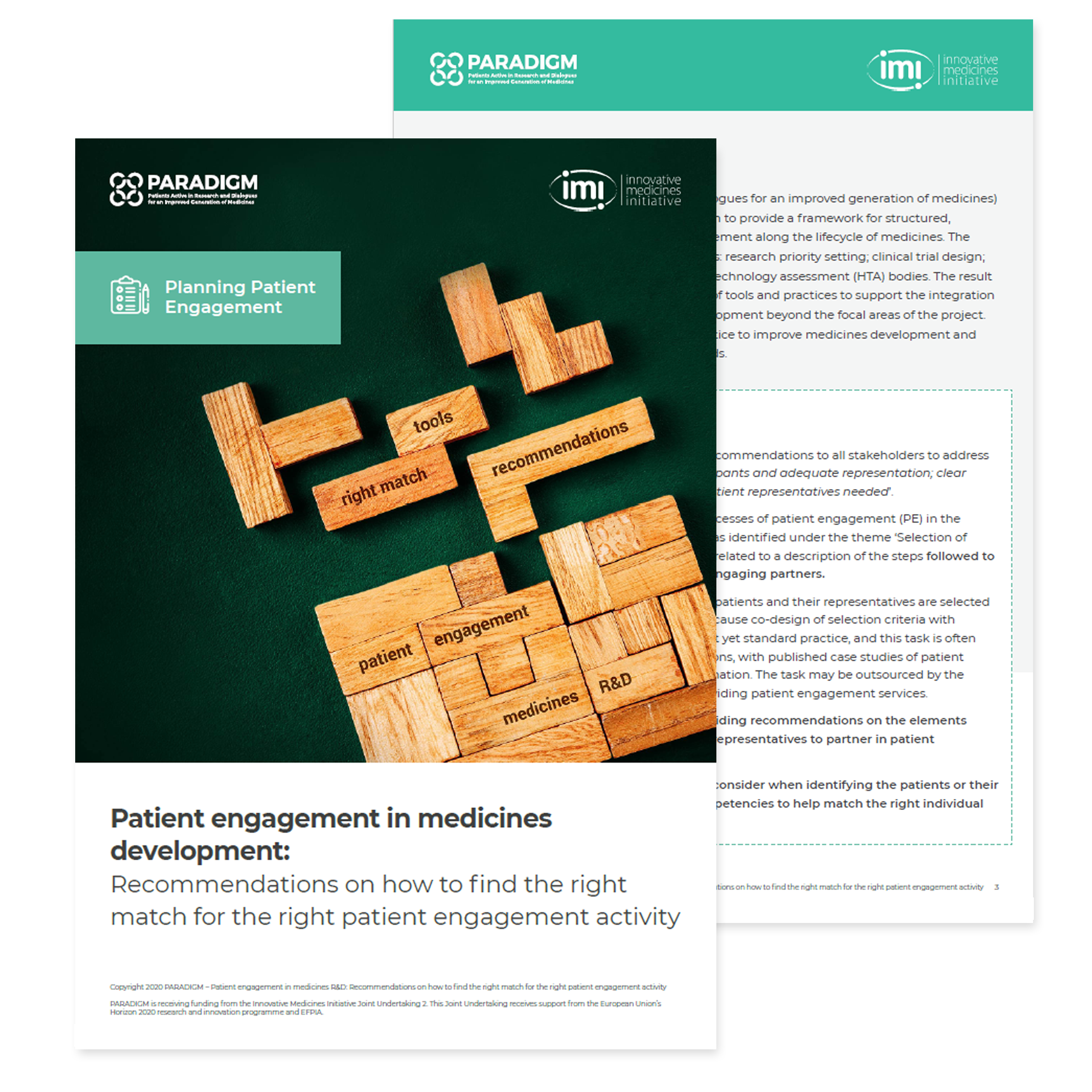
Patient engagement in medicines development: Recommendations on how to find the right match for the right patient engagement activity
Background/Rationale for the document
During the analysis of existing practices and processes of patient engagement in the context of the PARADIGM project, a clear gap was identified under the theme ‘Selection of participants and adequate representation’. This related to a description of the steps followed to identify patient representatives between the engaging partners.
Generally limited documentation exists on how patients and their representatives are selected prior to an engagement activity. This may be because co-design of selection criteria with the patient community is still evolving and is not yet standard practice, and this task is often managed internally within individual organisations, with published case studies of patient engagement not currently providing that information.
This document aims to address this gap by providing recommendations on the elements associated with identifying patients and their representatives to partner in patient engagement activities.
Objective of the tool
This document specifically addresses what to consider when identifying the patients or their representatives’ together with associated competencies to help match the right individuals for the right activity.
Summary of the content
- Key principles for the set of recommendations
- The steps to follow when finding the right matches for the right activity
- Recommended topics to consider about the patient organisations (POs) that could guide the decision about which are the best suitable POs to contact
- Check list of the elements to consider before engaging with a patient organisation to work on a patient engagement activity
- A competency table to identify the main attributes that would be the most suitable for a given patient engagement activity
- Methods and short description on how and when to best use them to capture insights from patients and their representatives
Key message
Detailed considerations to be taken into account for the identification of appropriate participants when planning the engagement of patients/POs in various activities related to medicines development.
Methodology
To fill the gap defined and described above from the IMI PARADIGM D2.2 Inventory of gaps in existing patient engagement practices and processes, a working group was formed representing patients and the pharmaceutical industry. The needs of people living with dementia and children/young persons as two of the target populations for the IMI PARADIGM project were also represented. Due to lack of representation from regulators and HTA bodies in this working group, insights from these two stakeholder groups were gathered during a second consultation phase.
A webinar involving all members of the working group was held with a follow-up online questionnaire to obtain additional input. This input enabled preparation and consensus on the discussion topics and approach for the workshop held in Brussels, Belgium on 10th February 2020. This workshop defined the areas of work and the sources to be used, identified the tools already created, with positioning of the recommendations agreed to avoid duplication with ongoing efforts, and to start the creation process which has resulted in this recommendation document.
The creation process was followed by two rounds of consultation, within WP4 of PARADIGM and then the entire PARADIGM consortium and the PARADIGM International liaison Group (PILG) and finally a public consultation process. All feedback received was addressed and consolidated. This was supported by the editorial team who worked to ensure consistency across the outputs.
Contributors
| Main authors Mathieu Boudes (EPF) Kay Warner (GSK) |
|
| Contributors Walter Atzori (Alexion) Tamas Bereczky (EPF) Maria Borrell (EURORDIS) Nicholas Brooke (The Synergist) Nikos Dedes (EATG) Daniel De Schryver (Janssen) Ana Diaz (AE) Michaela Dinboeck (Novartis) Lukas Eichmann (Novo Nordisk) Stuart Faulkner (Oxford University) Elisa Ferrer (EURORDIS) Jan Geissler (EPF) Dianne Gove (AE) |
Matthias Gottwald (Bayer) Jennifer Harris (ABPI) Karina Huberman (EATG) Laura McKeaveney (Novartis) Alexandra Moutet (UCB) Michela Onali (EURORDIS Chi Pakarinen (The Synergist) Chiara Panci (AIFA) Lisa Power (EATG) Daphnee Pushparajah (Alexion) Paul Robinson (MSD) Ann Single (HTAi) Iris Van den Brande (Roche) |
| Coordination Karina Huberman (EATG) Wolf See (Bayer) Ingrid Klingmann (EFGCP) |
Editorial committee Stuart Faulkner (Oxford University) Michaela Dinboeck (Novartis) |


